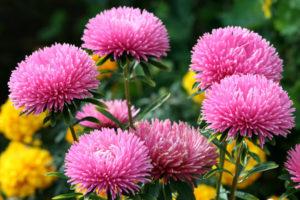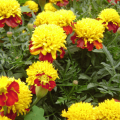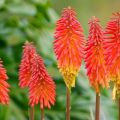Planting and caring for pyrethrum, flower varieties and growing rules
Feverfew is one of the unpretentious plants planted by gardeners. It has spectacular inflorescences of various colors. They look like chamomile flowers. This plant also has medicinal properties. Its flowers are actively used in folk medicine for the treatment of many diseases. Further information on planting and caring for feverfew in the garden.
General description and characteristics
Feverfew has several names: maiden chrysanthemum, exclusive matrix, Dalmatian, Caucasian chamomile. It is cultivated mainly as an annual. The height of the bushes varies between 20 centimeters and 1 meter.
The root system is powerful. The leaves are pinnately dissected, bright green. A chrysanthemum scent emanates from them. The buds are colored white, cream, yellow, pink. They bloom in late May or early June. Flowering lasts until frost.
Advantages and disadvantages of a flower
The positive qualities of pyrethrum include the following characteristics:
- spectacular appearance of plants;
- long flowering period;
- unpretentious care;
- good immunity;
- the possibility of using as a cutting plant.
No significant deficiencies were found in Dalmatian chamomile.

Varieties of pyrethrum
Specialists have bred many varieties of culture. The main ones are:
- Feverfew. The bush reaches a height of 50 centimeters. The flowers are simple or double. They are colored white or yellow. The most popular varieties: Zilbeoteppich, Dahl White, Virgo.
- Feverfew is scutellum. This is a tall variety of culture. 15-20 flowers grow on the stem. They are collected in loose shields. White-petaled buds bloom in June.
- Chamomile Robinson. Large buds of the culture are colored pink, red, purple. The Robinson Giants disband in June. Matricaria of this variety tolerates partial shade well.
- Feverfew is pink. The shoots of the plant grow up to 70 centimeters. In full dissolution, the buds of the Persian chamomile reach a diameter of 5 centimeters. The petals of the flower are pink, the center is yellow.
- Feverfew is red. It is also called the Caucasian chamomile, since the birthplace of the flower is the Caucasus. The leaves of the culture are double pinnately dissected. The petals of the buds are dark cherry.
- Perennial feverfew. The petals of the buds are colored white. Inflorescences can be simple or double. The height of the bushes is 20-100 centimeters.
- Feverfew Raspberry giants. Large chamomile inflorescences of the culture are colored crimson.The leaves are graceful, feathery. The bushes tolerate the harsh winter well.
- Feverfew Gold ball. The perennial plant is cultivated as an annual. The height of the bushes is 20-25 centimeters. Spherical inflorescences-baskets are colored yellow. Their diameter is 3-4 centimeters.
- Terry pyrethrum. The inflorescences of the culture have a double shape. The petals can be colored white, yellow, pink.
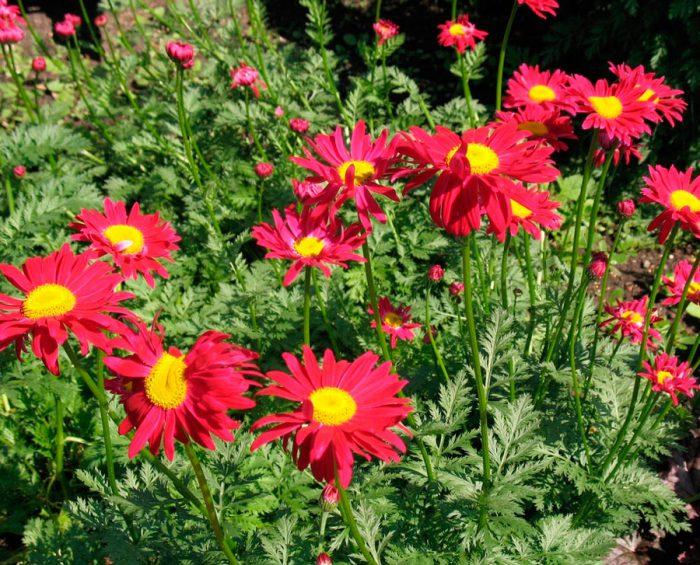
Additional Information. The plant is used in folk medicine as an antipyretic agent. For this property, the culture received the name "pyrethrum", which translates as "fever", "heat".
Landing subtleties
Matricaria begin planting in late February or early March. The seed is pre-stratified.
Soil and capacity
Many growers prefer pre-growing from seed. For sowing, containers with low sides are chosen. They are filled with a mixture of peat and sand. Seeds are spread over the surface, sprayed with water from a spray bottle, lightly sprinkled with a substrate. To maintain greenhouse conditions, the container is covered with foil.

Seedling care
The box with seeds is placed in a room with a temperature of 18-20 ° C. Covering material is removed every day to ventilate the crops. After emergence, the film is removed. When 3-4 leaves are formed on the seedlings, they begin to pick. To do this, each bush is carefully taken with tweezers, planted in a small pot. 2 weeks before planting in a permanent place, young bushes begin to harden.
Transplanting
Matricaria is planted on the site after the threat of frost has passed. For planting, select an area illuminated by the sun in the morning and evening hours. Almost all types of culture tolerate partial shade well.
Planting seedlings in open ground is carried out as follows:
- dig holes 20-25 centimeters deep at a distance of 25-30 centimeters;
- bushes are planted with a clod of earth;
- cover with a substrate;
- watered abundantly.
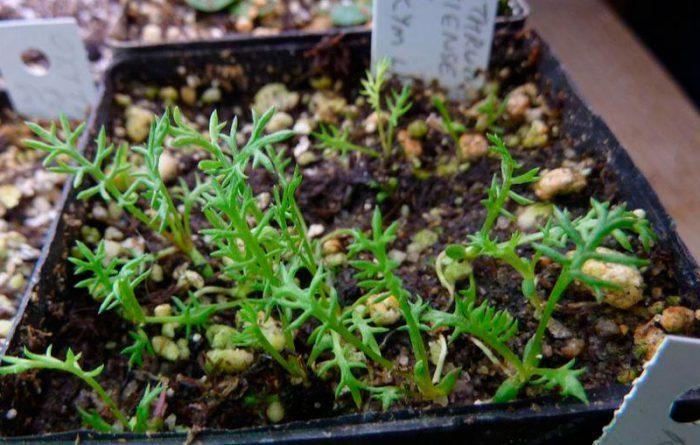
To retain moisture, the site can be mulched with peat, straw, grass cuttings.
Flower care rules
Care consists in watering, periodic feeding of plants. To maintain the decorative appearance of the culture, the stems with faded buds are cut off.
Watering
Feverfew has a well-developed root system. Therefore, the bushes do not need frequent watering. They irrigate the land only in case of prolonged drought. After watering, the soil is loosened. The procedure promotes air circulation for the root system.

Top dressing and fertilization
Feverfew prefers to grow in fertile soil. Therefore, nutrients are added at least 3 times per season. Use a complex mineral dressing. When digging the land, rotted manure is introduced.
Pruning
Faded buds are removed. The procedure contributes to the decorative effect of the bush. In addition, new shoots will grow from the dormant lateral buds. By the end of the season, the gardener will be able to admire the new blooming brushes.
Wintering
The aerial part of perennial pyrethrum species is cut off in late autumn. The trunk circle is sprinkled with peat or rotted manure. The mulching material will prevent the roots from freezing. In early spring, the mulch is raked off.

Protection against diseases and pests
Feverfew has good immunity. The culture is rarely affected by diseases and pests. The fungus is formed, as a rule, from an excess of moisture in the ground. Therefore, water the plants sparingly. Fungicides are used to prevent the appearance of diseases. The bushes affected by rot are removed from the site.
To prevent and get rid of harmful insects, insecticides are used. Foliage-eating slugs are harvested by hand.
Breeding methods
Dalmatian chamomile can be diluted on the site by seeds, dividing a bush, cuttings. Seed propagation is carried out in late winter or early spring.The seed is planted first in a shallow container. As the plants develop, they are seated in separate containers. The grown bushes are planted in the ground.
For cuttings, cut off the basal shoots. The lower parts are treated in a growth stimulator, planted in pots with loose soil. The containers are covered with foil. Soon, roots will begin to form on the cuttings. Well-rooted shoots are planted on the site. Once every 2-3 years, perennial feverfew is divided. The procedure is carried out in the fall. The root system is dug up, divided into parts. Each piece is planted in a previously prepared hole.
Application in landscape design
Low-growing varieties of pyrethrum are used for edging flower beds, planted as a border along the garden path. Tall bushes can be planted as a separate island against the background of the lawn. Culture is also decorated with mixborders, rabatki, flower beds. Plants look spectacular in combination with bells, foxgloves, carnations.
